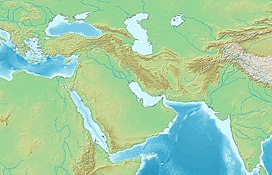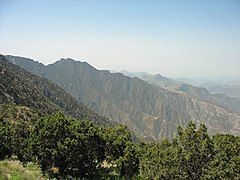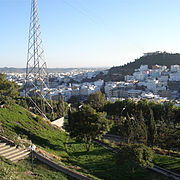Asir Mountains
| Asir Mountains | |
|---|---|
Arabic) | |
| Geography | |
| Country | |
| Region | Arabian Peninsula |
| Range coordinates | 21°36′N 39°48′E / 21.6°N 39.8°E |
The Asir Mountains
Geology
The mountains consist primarily of sedimentary rock, limestone, sandstone and shale, of Jurassic, Cretaceous and Paleogene origin on a Precambrian granitic basement.[2]
Climate and agriculture
The region has the highest average rainfall of Saudi Arabia[citation needed] due to largely seasonal rain. Average rainfall can range from 600 millimetres (24 in) to over 1,000 millimetres (39 in) per year, in wet regions. The eastern plains and plateaus receive much lower amounts, from 500 millimetres (20 in) to below 100 millimetres (3.9 in) per year.[2]
The region's crops, most of which are cultivated on steeply terraced mountainsides, include wheat, coffee, cotton, indigo, ginger, vegetables, and palms. The region also supports cattle, sheep, goats, and camels.[citation needed]
Biodiversity
The region's difficult terrain has helped preserve the region's unique biodiversity. Several new Myxomycetes fungi species have been discovered in the region, as have a variety of previously undiscovered plants.[7] Asir is also thought to be one of the last natural habitats of the Arabian leopard.[2][5][6] and also the Asir magpie, believed to be down to its last 135 pairs.[8]
Gallery
-
Jabal Sawdah("Mount Sawdah")
-
Abha City, located 2,270 m (7,450 ft) above sea level in the 'Asir Region
-
Habalah Valley near Abha
-
Al Soudah
-
Jabal Atherb, as seen from Ḥawālah in Bareq
See also
References
- ^ "Library of Congress Country Study: Saudi Arabia", The Library of Congress, archived from the original on 2008-09-23
- ^ a b c d "Southwestern Arabian montane woodlands". Terrestrial Ecoregions. World Wildlife Fund.
- ^ Overstreet, William Courtney (1977). Tertiary laterite of the As Sarat Mountains, Asir Province, Kingdom of Saudi Arabia. Vol. 2. Directorate General of Mineral Resources. pp. iii–2.
- ISBN 978-1-4629-1365-7.
- ^ a b Judas, J.; Paillat, P.; Khoja, A.; Boug, A. (2006). "Status of the Arabian leopard in Saudi Arabia" (PDF). Cat News. Special Issue 1: 11–19.
- ^ a b Spalton, J. A. & Al-Hikmani, H. M. (2006). "The Leopard in the Arabian Peninsula – Distribution and Subspecies Status" (PDF). Cat News (Special Issue 1): 4–8.
- ^ Boulos, L. (1985), "Myxomycetes from the Asir Mountains, Saudi Arabia (abstract)", A contribution of the flora of the Asir Mountains, Saudi Arabia, vol. 3, Arab Gulf Journal of Scientific Research, pp. 67–94, archived from the original on February 29, 2012
- ^ "Protecting the Asir Magpie".








